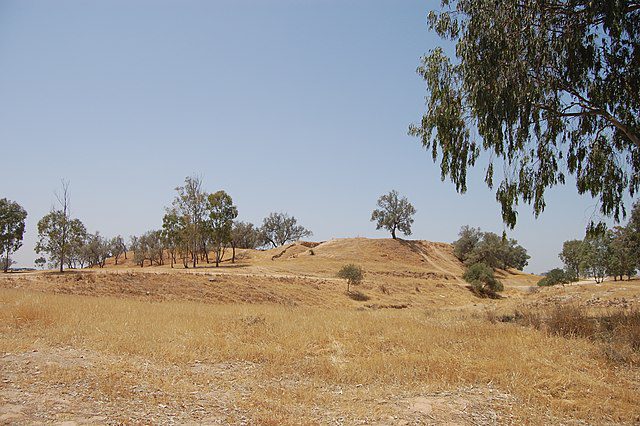
Anti-theist atheist Jonathan M. S. Pearce wrote the article, “The Exodus Debunked: You Philistines!” (3-9-18), to which I respond. His words will be in blue.
*****
[see the Bible passages in the Old Testament where the Philistines are mentioned (RSV): including Exodus 13:17 and 23:31 and eight times in Genesis]
Pearce makes another argument that reference to the Philistines in Moses’ time is anachronistic: thus suggesting that the Bible is 1) woefully inaccurate, or that 2) the book of Exodus was written way later than the time of Moses.
The basis for a lot of what I will be telling you will come from my friend and Skeptic Ink Network colleague Rebecca Bradley and her chapter, “The Credibility of the Exodus”, in John Loftus’ Christianity in the Light of Science . . .
[W]hatever the date chosen for the Exodus, believers must adhere to the idea that the Philistines were already established along the Mediterranean coast. Of course, you can guess what is coming next…
They weren’t.
This anachronism is rather similar to the camel issue and the pitch issue, both already mentioned.
I refuted the false claims about the alleged absence of camels in three papers (one / two / three), dealt with the supposed absence of pitch in the time and place of Moses’ birth (Pearce was dead-wrong again, according to archaeology, not the Bible only), and also supposed anachronistic biblical use of the term “Israelites”.
As Bradley states (p. 263):
This is a problem for even the “late date,” since the Philistines’ arrival was part of a dramatic process that only began at about 1200 BCE: . . .
…they were defeated in the epic battle with Rameses III in about 1180 BCE and then were allowed to settle along the southern coast of the Levant. From the late twelfth century BCE [i.e. 1100s BCE, not the 100 years earlier, the proposed later date of the Exodus], they were a strong presence in the form of the Philistine Pentapolis, until they came under Assyrian control in the eight century BCE, along with most of their neighbours.
. . . Simply put, when the Bible mentions the Philistines in this Exodus context, the Philistines did not exist. It’s not that they were there, but were called something else – it’s that they did not yet exist.
The problems with this scenario are not confined to merely the Exodus account. Genesis 21 and 26 have Abraham and Isaac visiting the Philistines some nine centuries before they existed! (Perhaps a series debunking Genesis is on the cards…) . . .
The only reason, as an objective historian, to maintain that the Conservative, traditional biblical interpretation of the Bible is correct would be that you really, really wanted the Bible to be correct.
Genesis 10:14 (RSV) Pathru’sim, Caslu’him (whence came the Philistines), and Caph’torim.
Cambridge Bible for Schools and Colleges comments on this passage:
The parenthetical clause within the brackets seems to be out of place. According to Deuteronomy 2:23, Jeremiah 47:4, Amos 9:7 the Philistines came out of Caphtor. Accordingly, we may conjecture the clause originally stood after the word “Caphtorim,” and has been accidentally transposed. On the other hand, this explanation seems so obvious, that some scholars consider that the clause “whence … the Philistines” is in its right place, but that the words “and Caphtorim” are only a gloss on the mention of “the Philistines.”
Deuteronomy 2:23 As for the Avvim, who lived in villages as far as Gaza, the Caph’torim, who came from Caphtor, destroyed them and settled in their stead.) [see more info. on the Avvim]
Jeremiah 47:4 . . . the LORD is destroying the Philistines, the remnant of the coastland of Caphtor.
Amos 9:7 . . . [God]: “Did I not bring up Israel from the land of Egypt, and the Philistines from Caphtor and the Syrians from Kir?
At this point I can imagine Pearce muttering to himself: “But this is from the Bible; who cares about that? It’s blind faith circular reasoning and so proves nothing . . .” Well, hold your horses, my friend. I’m just beginning my article, and this is the biblical background, which will be considered in light of the non-biblical sources I am about to bring to bear (and I will show that they are both in harmony, as always).
Josephus‘ Antiquities of the Jews i.vi.2, . . . placed them explicitly in Egypt . . . using extra-Biblical accounts [he] provides context for the migration from Caphtor to Philistia. He records that the Caphtorites were one of the Egyptian peoples whose cities were destroyed during the Ethiopic War. (Wikipedia, “Caphtor”)
Here is the passage in question:
Now all the children of Mesraim, being eight in number, possessed the country from Gaza to Egypt, though it retained the name of one only, the Philistim; for the Greeks call part of that country Palestine. As for the rest, Ludicim, and Enemim, and Labim, who alone inhabited in Libya, and called the country from himself, Nedim, and Phethrosim, and Chesloim, and Cephthorim, we know nothing of them besides their names; for the Ethiopic war, [*Antiq. b. ii. chap. x.] which we shall describe hereafter, was the cause that those cities were overthrown.
What Josephus calls the “Ethiopic War” occurred during the reign of Pharaoh Thutmose II (1493-1479 BC).
A location called Kaptar is mentioned in several texts of the Mari Tablets and is understood to be reference to Caphtor. An inscription dating to c. 1780-1760 BCE mentions a man from Caphtor (a-na Kap-ta-ra-i-im) who received tin from Mari [Syria]. Another Mari text from the same period mentions a Caphtorite weapon (kakku Kap-ta-ru-ú). Another records a Caphtorite object (ka-ta-pu-um Kap-ta-ru-ú) which had been sent by king Zimrilim of the same period [r. 1775-1761 BC], to king Shariya of Razama. A text in connection with Hammurabi [r. c. 1792-1750 BC] mentions Caphtorite (k[a-a]p-ta-ri-tum) fabric that was sent to Mesopotamia via Mari. An inventory thought to be from the same era as the previous texts mentions a Caphtorite vessel (GAL kap-ta-ri-tum) (probably a large jug or jar). (Wikipedia, ibid.)
Trude Dothan (d. 2016) received the coveted Israel Prize for archaeology in 1998, in recognition for her many years of excavating (at Deir el-Balah, Hazor and Qasile) and teaching (at Hebrew University, Princeton, New York University, Brown University and the University of California at Berkeley). One of the world’s leading authorities on the Philistines, Dothan is the author of The Philistines and Their Material Culture (Israel Exploration Society, 1982) and, with her husband, Moshe, of People of the Sea (Macmillan, 1992).”
She explains the well-accepted theory that the Philistines came originally from Crete, and thus reflected that background and the larger historical and cultural influence of the Mycenaean civilization of Greece (1600-1100 BC):
The homeland of the Philistines, Caphtor (Amos 9:7), is generally recognized by scholars as Crete, (although some believe Caphtor to be located in Cilicia in Asia Minor.)
In other Biblical references, the Philistines are synonymous with the Cherethites; that is Cretans (see Zephaniah 2:5 and Ezekiel 25:16). Various Biblical traditions suggest that the Caphtorim (or at least some of them) are to be identified with the Cherethites. Thus the Biblical sources seem to link the Philistines with a previous home in Crete. . . .
The detailed Biblical account of Goliath’s armor and weaponry is a vivid description of a Philistine warrior in full battle dress:
“And he had a helmet of brass upon his head, and he was armed with a coat of mail. … And he had greaves of brass upon his legs, and a target of brass between his shoulders. And the staff of his spear was like a weaver’s beam, and his spear’s head weighed six hundred shekels of iron; and one bearing a shield went before him.” (1 Samuel 17:5–7)
Goliath’s dress and armour (bronze helmet, coat of mail, bronze greaves [leg guards], and javelin) as well as the duel between champions are all well-known features of Aegean arms and warfare. They clearly indicate Aegean traditions carried on by the Philistines. The 12th century Warriors’ Vase from Mycenae shows Mycenaean warriors very similarly equipped. . . .
The shapes and decorative motifs of Philistine pottery were a blend of four distinct ceramic styles: Mycenaean, Cypriot, Egyptian, and local Canaanite. The dominant traits in shape and almost all the decorative elements were derived from the Mycenaean repertoire, and, as we have said, point to the Aegean background of Philistine pottery Philistine shapes of Mycenaean origin include bell-shaped bowls, large kraters with elaborate decoration, stirrup jars for oils and unguents, and strainer-spout beer jugs; the latter no doubt served as centerpieces at many a Philistine party. A few of the many decorative motifs are stylized birds, spiral loops, concentric half-circles, and scale patterns. Although Philistine vessels were richly decorated with motifs taken from the Mycenaean repertoire, these motifs were rearranged and integrated with other influences to create the distinctive “signature” known as Philistine. . . .
Female pottery figurines also reflect Philistine cult origins and beliefs. The “Ashdoda” is the only complete example of a well-defined type that was common from the 12th to the eighth century B.C. The Ashdoda figure is probably a schematic representation of a female deity and throne. It is clearly related to a grouping known throughout the Greek mainland, Rhodes and Cyprus—a Mycenaean female figurine seated on a throne, sometimes holding a child. These Mycenaean figurines are thought to represent a mother goddess. . . .
Burial customs are generally a sensitive indicator of cultural affinities, and Philistine burial customs reflect the same fusion of Aegean background with Egyptian and local Canaanite elements that distinguishes every other aspect of their culture. (“What We Know About the Philistines”, Biblical Archaeology Review, July/August 1982)
***
Genesis 26:1 Now there was a famine in the land, besides the former famine that was in the days of Abraham. And Isaac went to Gerar, to Abim’elech king of the Philistines.
I accept the life and death dates of Abraham as being c. 1813 BC-c. 1638 BC (this period is the Middle Bronze Age II, for the Near East), based on the estimate of the Jewish Virtual Library. In 1956, the eminent Israeli archaeologist Yohanan Aharoni identified the Tel Haror site as the biblical Gerar. It’s located in the western Negev Desert of Israel, between Gaza and Beersheba, some 14 miles from the Mediterranean Sea. This is the ancient territory of the Philistines. Could it have been visited by Isaac, as the Bible states? Yes! The Wikipedia article on the archaeological site states:
During the Middle Bronze Age II it was one of the largest urban centres in the area, occupying about 40 acres. The city contains substantial remains of Middle Bronze Age II through to Persian-period settlement strata.
The Middle Bronze Age in the Levant ran from 2000-1550 BC, with Middle Bronze Age II referring to 1750-1650 BC.
A Minoan graffito was found in the sacred precinct dating to ca. 1600 BCE. Analyses of the sherd determined that it originated in Crete, most likely the south coast. (Ibid.)
For more information on this find, see: Day, Peter M., et al. 1999 “Petrographic Analysis of the Tel Haror Inscribed Sherd: Seeking Provenance Within Crete.” Aegaeum 20: 191–96; and Oren, Eliezer D., et al. 1996 “A Minoan Graffito from Tel Haror (Negev, Israel).” Cretan Studies 5: 91-118.
Israeli archaeologist Avner Raban (1937-2004) wrote a very educational article in 1991, entitled, “Minoan and Canaanite Harbours.” Aegaeum 7: 129-46. It has many tie-ins to our subject matter, and supports a notion that commerce may have been what brought the Philistines from Crete to Canaan (and to Egypt):
Cretan artifacts were found in [Egyptian] 12th dynasty [1991-1802 BC] sites in many places along the Nile Valley (such as Karun, Gahob, Abydos and even in the oasis of Harageh). Egyptian artifacts of that period were found at Cretan Middle Minoan [2100-1600 BC] context . . . Similar Middle Minoan II [1800-1700 BC] artifacts were found in Levantine trade centres such as Byblos [Lebanon], Ugarit [Syria] and even the inland Qatna [Syria] . . .
Sargon I [20th-19th c. BC] of Akkad (Agade) mentioned Crete (. . . the biblical Kaphtor) together with sources of metal ores from over the Mediterranean, already in the 24th century B.C.E. and a broken Akkadian cuneiform inscription of around 1800 B.C.E. was found on the island of Kythera [island between the Greek mainland and Crete]. An early Babylonian cylinder seal of about the same period in Tholos B in Platanos, in the Messara Valley in Crete. (p. 144) [my bracketed material and links]
Australian archaeologist Robert Merrillees reports in his 2003 article, “The First Appearances of Kamares Ware in the Levant.” Egypt and the Levant 13: 127-42, on the discovery of a portion of a Minoan cup from around 1800 BC, that was found in Ashkelon, part of ancient Philistia, on the coast.
At Tel Kabri in present-day northwest Israel on the coast, are archaeological remains “containing one of the largest Middle Bronze Age (2,100–1,550 BCE) Canaanite palaces in Israel” (Wikipedia). The article continues:
Among the discoveries at the site by the two full-scale archaeological expeditions, two have attracted particular attention from the archaeological community. The first finding to come to international attention was the discovery of Minoan-style frescoes in the palace at Kabri. As of 2015, these are the only Minoan paintings ever discovered in Israel.
Sources:
Cline, E. H.; Yasur-Landau, A.; Goshen, N. (2011). “New Fragments of Aegean-Style Painted Plaster from Tel Kabri, Israel”(PDF). American Journal of Archaeology. 15 (2).
Science Daily (7 December 2009). “Remains Of Minoan-Style Painting Discovered During Excavations Of Canaanite Palace”.
These have been dated by Cline et al to the 17th century BC (p. 245; Abstract).
No one needs to hold that these earlier Philistines from Crete were a great nation prior to the 12th century BC, when everyone believes they quickly became so. But archaeology suggests that there were enough of them present in the region, to be mentioned as such in the early Bible passages.
Nature (7-4-19) reports:
The Philistines appear repeatedly in the Bible, but their origins have long been mysterious. Now genetic evidence suggests that this ancient people trace some of their ancestry west all the way to Europe.
Choongwon Jeong and Johannes Krause at the Max Planck Institute for the Science of Human History in Jena, Germany, and their colleagues analysed the DNA of ten ancient people whose bones were found in Ashkelon, a Philistine city located in modern-day Israel. The DNA suggests an influx of people of European heritage into Ashkelon in the twelfth century BC. The individuals’ DNA shows similarities to that of ancient Cretans, but the team warns that it is impossible to specify the immigrants’ homeland because of the limited number of ancient genomes available for study.
The closest DNA match was Crete: about 43%. So once again, we see that archaeology has supported biblical accuracy. The Philistines (according to genetics) likely originated in Crete, just as the Bible stated in Genesis, Jeremiah, and Amos. And significant numbers of them were present in Egypt and Canaan before 1200 BC: again, precisely as the Bible states.
Note also that when the Bible mentions Isaac’s visit to the Philistine king Abim’elech (1950 BC or so), no mention is made of the five famous cities of Philistia: Gaza, Ashdod, Ash’kelon, Gath, and Ekron (Joshua 13:3). They were much more important later. All that was mentioned was Gerar, which I have shown from archaeology was flourishing at that time. But if the Bible were so anachronistic, as charged, it seems like it would have mentioned them. Instead, it’s historically accurate.
And we would expect the systematic historical and archaeological accuracy that we actually find, in a book believed in [very reasonable] faith by Christians and Jews to be the inspired revelation of God.
***
Photo credit: Aaadir (4-29-21). Tel Haror, widely thought to be the remains of the biblical city of Gerar. [Wikimedia Commons / Creative Commons CC0 1.0 Universal Public Domain Dedication]
***
Summary: Atheist JMS Pearce tries to argue that the early biblical references to the Philistines are anachronistic: thus proving the inaccuracy of the Bible. Wrong again!: says secular archaeology.
***













